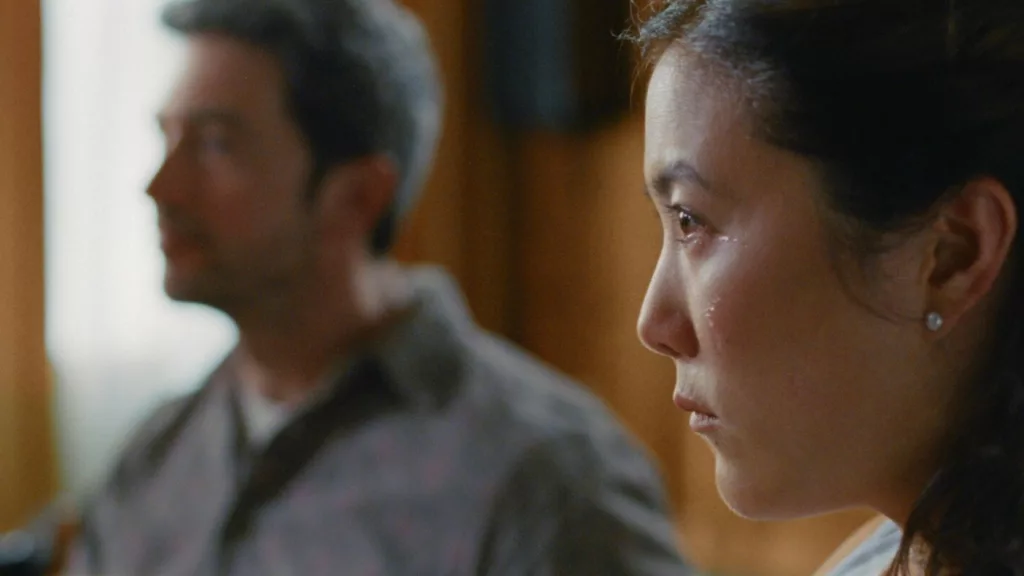Director Meredith Hama-Brown Navigates Grief and Intergenerational Trauma in Debut Film, “Seagrass”

In 2023, Seagrass premiered at the Toronto International Film Festival and gained international acclaim. The film won TIFF’s International Film Critics Prize and was nominated for Vancouver Film Critics Circle’s Best Screenplay as well as Best B.C. Director, which Meredith Hama-Brown took home. Then in February, Seagrass had its theatrical release in the United States and Canada.
Seagrass is Hama-Brown’s debut feature film and stars Ally Maki as Judith, Luke Roberts as Steve, Remy Marthaller as Emmy, and Nyha Huang Breitkreuz as Stephanie. The film centers around Judith who, after the loss of her mother, brings her family to a couples’ retreat where she hopes to mend her strained relationship with her husband. The story explores Judith’s Japanese Canadian identity, her relationship with her Caucasian husband, and her inability to connect with either. It is also a story about the kids Emmy and Stephanie, who begin to feel the effects of their parents’ collapsing marriage.
EnVi had the opportunity to speak with Vancouver-based director Meredith Hama-Brown over email about her filmmaking journey, the development of Seagrass, and the film’s exploration of grief and intergenerational trauma.
A Film Worth Pursuing
Despite growing up with a love for storytelling, Hama-Brown recalled that she never saw filmmaking as a career path. “I didn’t grow up in a town with a film industry,” she said. “I probably learned that I wanted to be a filmmaker when I attended university and found my way into the film production program. It was there that I really started to cultivate a deep love for filmmaking.”
Hama-Brown began writing Seagrass in December of 2018 and drew from her Japanese Canadian heritage for the story. Similar to Judith and Steve, Hama-Brown’s mother is also Japanese Canadian and her father is Caucasian. They divorced when she was young, but the similarities with the Seagrass family end there.
Seagrass actively explores the intergenerational trauma rooted in the unjust incarceration of Japanese Canadians during World War II. There is also a deep analysis of interracial marriages, with Judith being Japanese Canadian and her husband Steve being Caucasian. The film looks into the disconnect with one’s heritage as well as the potential microaggressions that can occur in an interracial marriage. So while the story of Seagrass is fictional, the emotions portrayed are very much real.
“Once I started writing and the pieces came into place, I knew that this would be a first feature film worth pursuing for me,” Hama-Brown said. “From the beginning of the writing process, I felt intuitively that this was the right story for me to tackle and something that I could see myself committing to for the many years it would take to make the film.”
Grief and Loss of Heritage
Grief manifests in many forms, and Hama-Brown spends time exploring the ways grief touches our lives. In Seagrass, Judith packs a blanket for their family trip, which viewers later learn was made by her mother who used to sew together old sweaters. With a single description, Hama-Brown effectively captured Judith’s own grief and the struggles of Japanese Canadians during World War II. As the film progresses, the audience comes to realize that this blanket tethers Judith to her mother — and her Japanese heritage.
There is a scene where Judith is comforting her younger daughter Emmy after a late night scare. The two sit on their porch with the blanket spread across their laps. Emmy asks, “What does Grandma like to do?”
Her mom responds, “She likes to see you.”
To which Emmy asks, “But other than that?”
After a breathtaking pause that feels like eternity, Judith admits, “I don’t know.” This is the first of many instances where Judith faces questions about her mother — and her Japanese identity — that she cannot answer.
Judith isn’t just grappling with the loss of her mother in Seagrass. She is grappling with the loss of her only connection to her Japanese heritage, and Hama-Brown explores these nuanced layers of grief with great tenderness.

The family’s grief and tension also are portrayed through the camerawork. Throughout the film, there are scenes where the camera sweeps into the room from above, indicating the possibility of the grandmother’s ghost watching over the family. These wide shots heighten the tension and sense of eeriness.
When asked how she and cinematographer Norm Li came up with this idea, Hama-Brown responded, “This idea really started in the script stage as I wanted to have a camera that could represent the possibility of the grandmother’s ghost. So these sweeping camera moves could really be interpreted as the grandmother’s character as she watches over the family.”
However, Hama-Brown didn’t want this to be “solely scary.” She wanted the camerawork to be interpreted symbolically as well. “This camera could represent the family’s fears, the sense of discomfort that weighs on them, the parts of their lives that they don’t understand and the intergenerational trauma that haunts them since the unjust incarceration of Japanese Canadians in the 1940s,” she said. “Either way, Norm and I talked about not making these camera moves feel solely scary but for them to also have an organic and beautiful aspect to them. This was important as no matter what these camera moves represent to viewers, in the end we wanted it to carry the message that in some way it looks over the family.”

Adolescence and the Loss of Innocence
Grief haunts Judith and her family in more ways than one. With each passing day, Judith confronts questions about her heritage. Meanwhile, Steve is unable to understand his wife’s struggles and is ill-equipped to console or connect with her. As their marriage deteriorates, it is Emmy and Stephanie who feel the repercussions of their parents’ pain.
While their parents attend group couple’s therapy, the kids are allowed to explore the island. Stephanie, who is the oldest of the two, has an easier time making friends compared to Emmy who finds it hard to connect with the other kids. When she is shown a cave that’s said to be capable of communicating with ghosts, Emmy begins to believe that her grandmother’s ghost is in there. Further into the film, Stephanie begins to struggle with the power-dynamics of her friendships with other girls, and Emmy begins to grow more fearful of her late grandmother.
As a result of their own personal struggles and their parents’ failing relationship, the sisters begin to clash. Yet underneath the tension, hurt, and envy, there is a deep sense of love between the two, which Hama-Brown ensures will never be overlooked by the audience.
“I had a fairly clear sense of Emmy and Stephanie’s dynamic early on since I knew that I wanted to explore the complexities within family dynamics,” Hama-Brown said. “I’m fascinated by the contradictions that can occur in many families. The sibling dynamic that felt most interesting to me, was one that was at once tense and a point of conflict but also incredibly loving at the same time.” Then she added, “However, it did take time in the writing process to really find their dynamic and get specific with what was happening for them in this relationship.”

The themes of adolescence and innocence (as well as the loss of such things) are not new in Hama-Brown’s work. Her critically acclaimed short film Broken Bunny provides a deep dive into the loss of innocence when a girl finds an injured rabbit. “I think these are some of the themes that I naturally gravitate towards,” Hama-Brown said. “I imagine that I will likely be drawn to them in some way in the future. I think there is so much to uncover in these themes. Whether it is delving into how innocence inevitably is lost or the ways that we are challenged as we relate to those around us, I’m very drawn to these themes because of their complexity.”
A Film to be Remembered
With an outstanding cast, innovative camerawork, and a memorable script to be thought about long after leaving the theaters, Seagrass is a quiet film that utilizes thriller-esque tension without losing emotional poignancy.
When asked if there’s a specific emotion she’d like the audience to leave the theaters with, Hama-Brown said, “I wouldn’t say that there is a specific emotion that I hope people will leave with but I do hope that they will feel an emotional impact from the film in some way. I think the film requires some processing so I also hope that people will think about it and digest it after viewing it.”
She concluded, “Of course, I hope viewers will leave feeling a sense of connection as well with the themes that the film explores.”
Seagrass is now available on VOD. Follow Seagrass’s official Instagram and Meredith Hama-Brown’s Instagram for updates on her latest projects.
*Editor’s Note: This interview has been edited for length and clarity.
Want to discover more API films? Check out our article on five API love stories at Sundance here!



